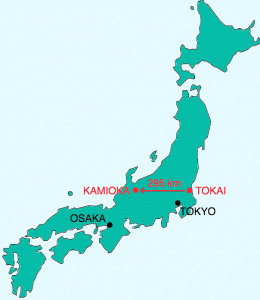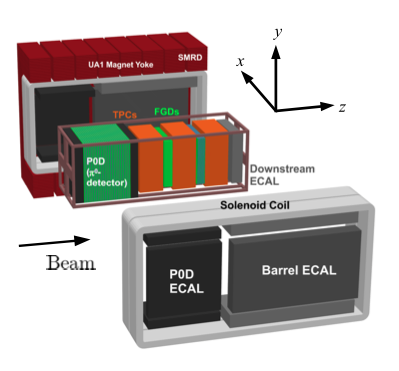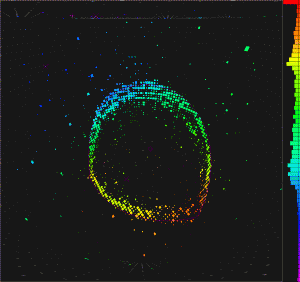
The T2K (Tokai to Kamioka) experiment is a neutrino experiment with a “long-baseline” facility (consisting of a particle accelerator with a long beam propagation line) in Japan that focuses on the study of neutrino oscillations. Neutrinos are elementary particles of three “flavors”: electron, muon and tau neutrinos. They interact only through the weak nuclear force and are very difficult to detect, as they rarely interact with matter. Electron neutrinos are produced in large quantities in the Sun, and these solar neutrinos are capable of passing through the entire Earth without interacting.
T2K performed a search for muon neutrino to electron neutrino oscillations, announcing the first experimental evidence of them in June 2011. These oscillations had never been observed by any previous experiment. T2K is also performing measurements of oscillations between muon neutrinos and tauon neutrinos (which had already been observed in previous experiments), which will be the most precise measurements to date of the probability of these oscillations and of the difference between the masses of two of the neutrinos (to be precise, T2K measures the difference between the squares of these masses).
T2K neutrino beam

The T2K experiment sends an intense beam of muon neutrinos from Tokai, which is located on the east coast of Japan, to Kamioka, at a distance of 295 km in western Japan. The neutrino beam is produced in collisions between a proton beam and a graphite target; these collisions produce pions, which are collimated into a beam by magnetic devices called horns. These pions disintegrate rapidly into muons and muon neutrinos. The muons and the remaining protons and pions in the beam are stopped by a second layer of graphite (called a beam dump, which acts as a beam collector), but the neutrinos are able to pass through this layer. The energy of the neutrinos in the beam is important, since the oscillations depend on it: low energy neutrinos oscillate over a shorter distance than high energy neutrinos. The T2K neutrino beam has an energy range centered on 600 MeV, since muon neutrinos with this energy are more likely to oscillate after traveling 295 km.
T2K has also started (in 2014) to take data using a muon antineutrino beam. This is because it is believed that equal amounts of matter and antimatter were produced in the Big Bang and it is not yet understood why the present Universe is composed entirely of matter. Thus, using a beam of antineutrinos will make it possible to find an answer to this problem by comparing antineutrino oscillations with neutrino oscillations.
The T2K detectors

Components of ND280 near detector
It is essential that the direction of the neutrino beam is stable to an accuracy of 1/20th of a degree and that the beam intensity is constant over time. The direction and intensity of the beam are checked daily by the interactions of the neutrinos with the iron in the nearby Interactive Neutrino GRID (INGRID) detector, which is composed of an interactive network of vertical and horizontal modules. This detector is located 280 meters from the graphite target and centered in the direction of the neutrino beam.
T2K studies neutrino oscillations with two different detectors, both located at 2.5 degrees to the central direction of the neutrino beam. The near detector, called ND280 (NearDetector280), is also 280 meters from the target, and measures the number of muon neutrinos in the beam before oscillations occur. T2K neutrinos have much higher energies than solar neutrinos, making these high-energy neutrinos more likely to interact with matter. A small number of muon neutrinos interact with the scintillator or water present in ND280, and many of these interactions produce a muon. The muon is a charged particle, and can be detected as it ionizes the gas that is placed immediately after the interaction points. These ND280 measurements are used to predict the number of muon neutrinos that would be seen in the SuperKamiokande “far detector” if there were no oscillations.
Most of the neutrinos pass through the ND280 without interacting, and these travel at near the speed of light to Super Kamiokande (Super K). This is located 1000 metres underground in western Japan, and is 295 km from the target in Tokai. At the Super K detector, the neutrinos enter a very large cylinder of ultra-pure water. Again most of the neutrinos pass through without interacting but, due to the high energies of the neutrinos and the intensity of the beam, some do interact with the water.

Many of the interactions of muon neutrinos produce muons, while interactions of electron neutrinos often produce electrons. Muons and electrons are charged particles, and they displace electrons in the water as they pass. As the water electrons return to their equilibrium positions after the passage of the charged particle, they emit light. If the passing charged particle is travelling faster than the velocity of light in water (which is three-quarters of its velocity in a vacuum), this light is emitted as a cone known as Cherenkov radiation. The walls of Super K are lined with more than 10,000 sensitive photo-multipliers, which detect the cone of Cherenkov light as a ring. Super K can distinguish muons (which produce a sharp ring) from electrons (which produce a more diffuse ring).

For an almost-live event display from Super-K, click here. You will see a map of the phototubes inside the Super-K detector, from an event recorded a short time ago. The display will update every few seconds. These are just a random sample of the events recorded every second at Super-K. (For an explanation of the event display, click here). Most of the events you see will be downward-going muon tracks, NOT T2K beam neutrinos! In fact, most of the neutrino interactions we sift out of the millions of events recorded at Super-K are caused by neutrinos from the Sun or the Earth’s atmosphere. Only a few hundred neutrino interactions per year are due to beam neutrinos traveling from J-PARC.
The oscillations from muon neutrinos to electron neutrinos were seen in Super K as the diffuse rings from electrons produced in interactions of electron neutrinos with the water. 28 electron-neutrino events have been seen in Super K, whereas only 4.6 would have been expected if there were no oscillations. The probability that these 28 events were due to a process other than oscillations from muon neutrinos to electron neutrinos is tiny at 10-13, and confirms that these oscillations are occurring.
T2K is also studying oscillations from muon neutrinos to tau neutrinos, and these are seen as a reduction in the number of muon neutrinos detected in Super K compared with the ND280 prediction for no oscillations.
Advantages of an Off-Axis Experiment
T2K is the world’s first off-axis neutrino experiment, with ND280 and Super K positioned 2.5 degrees away from the centre of the neutrino beam.
The off-axis part of the beam has a narrower range of energies than the on-axis part, which means that a larger fraction of neutrinos change the flavor by the time they reach Super K. Also the most important measurement is that of neutrino energy and this measurement is made most accurately from events in which a neutrino interacts with a neutron in the detector to produce a muon and a proton. The off-axis part of the beam has a larger fraction of these events than the on-axis part, which enables T2K to make more accurate measurements of neutrino energy. This leads to more accurate measurements of the probability of neutrino oscillations and neutrino mass differences than those from previous experiments.










